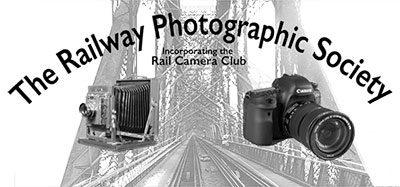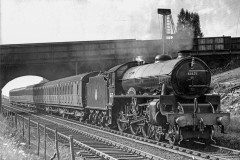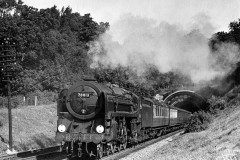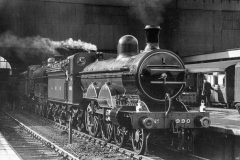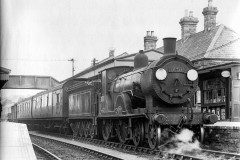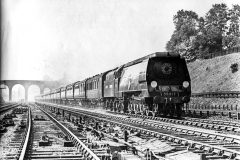About Derrick Dant
Derrick Dant was born in Cambridge on 5th January 1923 in the earliest days of the Grouping and just as the first Gresley pacifics were emerging from Doncaster Works. It is perhaps unsurprising, therefore, that his lifelong railway passion was for all things LNER.
Derrick discovered ‘train spotting’ in the late summer of 1934 whilst awaiting the start of his first term at grammar school. Along with three or four like-minded classmates, who remained close friends for the rest of their lives, the comings and goings of rail traffic in and out of Cambridge were closely observed. As well as the lines south to Kings Cross and Liverpool Street there was also a steady diet of ex LNWR locos on trains to Bletchley and beyond. Their study was very much aided by the fact that the railway ran alongside the school playing fields. Outside school hours every bit of spare time seems to have been spent either at Hills Road Bridge or on the footbridge leading to Cambridge shed.
Cambridge was regularly the destination for newly out-shopped locos on running in turns from Kings Cross so it was quite normal to see Gresley pacifics on these turns. However, imagine Derrick’s shock and wonderment when early one Saturday morning in September 1935 a sleek grey shape slid quietly under Hills Road Bridge and he saw the name Silver Link painted on the side of the boiler. Having recovered from his initial shock he dashed around as many of his spotting friends as he could before the return run just after 11.00am.
Information about train movements was difficult to come by in those days, but somehow one of the group of spotters got to know in advance the timings for the funeral train of King George V on 23rd January 1936. As a result, and following a discrete request to one or two sympathetic masters, a fairly large crowd of pupils and masters was standing at the end of the school playing fields to watch B17 no 2847 Helmingham Hall steam slowly by with the Royal Funeral train en route from Sandringham to Kings X.
By the end of the 1930s and having passed his School Certificate Derrick decided to leave school and seek office employment. This was, of course, in the shadow of looming War and almost immediately following the outbreak of War the spotters of Cambridge noticed changes in the flow and quantity of rail traffic.
Derrick managed to secure a job in a Civil Service Department which had recently been evacuated from central London and was now based in Caius College. Whilst this job provided funds for exploring the railway system further afield, it also restricted his spotting activities to weekends and evenings. However, his younger friends who were still at school kept him appraised of day-to-day activity around Cambridge.
During 1940 a new face appeared amongst the spotters on Hills Road Bridge who turned out to be one Arthur Cook – later Dr A F Cook MA. Arthur was at Cambridge University doing post-graduate study, but more importantly he seemed to know valuable contacts within Doncaster Works. He was also a member of the Cambridge University Railway Club. Because of wartime student restrictions the CURC was suffering a downturn in members and so some of the local enthusiasts were invited to join the club as ‘associate members’ until the end of the War.
Meanwhile back in the office Derrick was delighted to find two fellow railway enthusiasts one of them being RPS member, Ernest R Wethersett whose photographs in The Railway Magazine Derrick had admired over the years. And it was E R Wethersett who encouraged Derrick in the art of railway photography and acted as his mentor. Indeed, Derrick’s first recorded photographs date back to 1940 and one can only assume that these were encouraged by Wethersett.
However, as 1942 dawned Derrick, realizing that he would probably be called up before too long, pre-empted the moment and applied to join the Royal Corps of Signals. On 26th January he was posted to Ossett for six weeks of basic training. This posting also provided spotting (and limited photographic opportunities) in the area. Then a move to Huddersfield followed intended for Signals technical training. Alas, in late May he succumbed to acute rheumatic fever spending the summer in hospital in Huddersfield followed by a further two months convalescence at Ranmoor Hall, Sheffield. At this point Derrick was discharged by the Army as unfit for further service.
So it was that in January 1943 Derrick returned to his former office and continued regular observations on the Cambridge scene. It must have been around this time that, on the advice of Wethersett he up-graded his film camera to a quarter plate camera (which is still in the author’s possession!) and started to learn to art of railway photography. In 1945 as VE day approached Derrick’s office was moved back to London taking him and Wethersett with it. Needing to find an appropriate home in the London suburbs Derrick once again sought Wethersett’s help. It was he who suggested that Potters Bar was easily commutable and that from a photographic point of view offered many advantages. In particular, being at the top of the climb out of Kings X northbound trains would not be travelling too fast and therefore more easily ‘stopped’ by the camera. The area was one with which Wethersett was well acquainted and his advice was taken.
Derrick set up house within easy walking distance of Potters Bar station and it is in this area that the bulk of his twelve hundred plus photographs were taken, aided no doubt by an LNER all line photographic pass issued by George Dow. It would have been around this time, (late 40s/early 50s) that Derrick – again, one would imagine, with the encouragement of Wethersett – joined the Railway Photographic Society and started submitting his photographs for appraisal, a process which he found quite intimidating. He had established a darkroom in the small third bedroom of his house and processed all his own plates using an enlarger made by one of his Cambridge friends who later went on to build the first electron microscope.
Derrick continued using his plate camera until mid1957 one of his last photographs recording the retirement run of Ted Hailstone on 4th April 1957. Being one of the platform 10 group of spotters Derrick had got to be friends with a number of the top link drivers and it was Ted who gave him a return trip to Newcastle on the footplate, an experience he treasured for the rest of his life.
At this point one must assume that Derrick’s membership of the RPS had ended as photographically he recorded the end of steam on 8mm cine film before eventually investing in a 35mm SLR to record preserved steam and then, finally, onto Betamax and VHS.
Derrick died in 2002.
Nigel Dant April 2025
All images in this gallery © Nigel Dant
